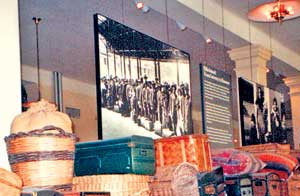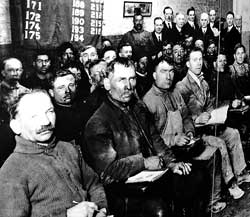
In search of the 'American Dream'Amazing journeys of immigrants who entered the USA through Ellis Island We've been standing in the freezing cold for over three hours. A biting February wind is blowing in from the New York Harbour, and I have to buy an extra muffler from the street vendor to wrap around my face. It's a Sunday morning in Battery Park, Manhattan, and we're among the hundreds of visitors from around the world, waiting to board a ferry to Ellis Island. Some are Americans, looking for keys to their past, and others, hoping to catch a glimpse of what it was like to enter the New World almost a century ago.
Lying in the shadow of the Statue of Liberty, this small island is a symbol of American immigration. From 1892 to 1954, over twelve million immigrants entered the United States through this gateway, which was the chief immigration station for the country. Today, the main building of the station has been converted into an Immigration Museum, and is one of the country's most popular historic sites, telling the moving stories of those immigrants who left behind everything they knew in search of the 'American Dream'. Almost half of the American population can trace their ancestry back to the doors of Ellis Island – and many come here in the hopes of doing so. For now, it seems that we will never get there. The tickets have been bought from Castle Garden, a magnificent old building in the Park, which was the immigration station prior to Ellis Island. We've taken our places in the queue that seems endless. A dark-skinned street musician, with hair that is a riot of colours, entertains us with impromptu songs. "Come and give me a hug, tell me where you're from!" he yells cheerfully, "and I'll sing you a song with your name!" Many people oblige, and there is a lot of laughter. Finally, the line moves, and we are subjected to a security search before we board the ferry. Jackets, purses, mobile phones and keys must all be handed over. The ferry also makes a stop at Liberty Island, and the post 9/11 regulations are strict – for one thing, tourists are no longer allowed to go beyond the statue's pedestal. Both Ellis Island and the Statue are precious icons of their identity to Americans. Inside the ferry it is warm. We buy packets of roasted peanuts and settle down near the windows for the ride to the island. Soon, we look out at the spectacular view of the Manhattan skyline – a skyline that was almost the same, a hundred years ago, welcoming immigrants who had never seen anything like it before in their lives. We pass by the Statue of Liberty, standing proudly on Liberty Island, the copper flames of her torch glinting in the afternoon sunlight. A few passengers disembark, while the rest of us continue onto Ellis Island. The island itself is tiny, an area of about 32 acres, mostly artificially created by landfill. Outside the museum is a startlingly long wall inscribed with thousands of names – claimed to be the longest wall of names in the world. This unique display contains more than 700,000 names of immigrants and travellers who passed through Ellis Island inscribed for posterity by family members and friends. These include world-famous figures such as Albert Einstein, Harry Houdini, and Colonel John Washington, great-grandfather of George Washington.
In the museum, we take a journey through time, reliving the experiences of the immigrants who often braved terrible conditions at sea, travelling for months in search of a better life in an unknown land. There are innumerable passenger records, and it is said that over a 100 million Americans can trace their family's history here. A large screen displays the census of the many different ethnicities in the USA. We type in Sri Lanka, and it shows a number of 27,000 Sri Lankans living here today. We see old posters welcoming the newcomers, and advertising evening English classes. There are collections of clothes, trunks and tools that immigrants brought with them from their homelands. A small glass case displays the shoes worn by young children on the ships. There are framed letters written by the immigrants to their families back home, exclaiming over the bounties of this rich new country, and encouraging them to make the journey here. Of course, many would never see their families again, at the time; to travel to America was almost like travelling to the moon, in the words of one 19th century immigrant. Strolling through this unique display of America's cultural heritage, we are struck by the amazing journeys and experiences that went into making America what it is today. At 4 pm the last boarding call for the ferry is announced, and we scramble back to yet another long queue outside the museum. The ferry ride back is shorter, since we don't go by Liberty Island. The sun is already low over the buildings, night falls quickly in winter. The musician with the brilliant hair has left. The crowd disperses, and scatters into the vibrant and throbbing life of New York City, uplifted by the dreams of those who stepped on its shores many years ago. "Island of Hope, Island of Tears" Immigrants arriving in Ellis Island in the early 1900's were first screened for health. Wealthy immigrants who travelled first and second class were awarded automatic entry into the United States, while others had to pass a six-second physical examination. It was said that doctors could identify various medical conditions ranging from anaemia to goitre by just a glance. Those with visible health problems were sent home or held in the island's hospital facilities for long periods of time. Some immigrants, mainly the 'unskilled workers', were rejected outright because they were considered "likely to become a public charge". About two percent were denied admission and sent back to their homelands for reasons such as disease, criminal background, or insanity. Occasionally families would be separated. For those who passed through the initial screening, a new life awaited them beyond the shores of the New York Harbour. |
|
||||||
|| Front
Page | News | Editorial | Columns | Sports | Plus | Financial
Times | International | Mirror | TV
Times | Funday
Times || |
| |
Reproduction of articles permitted when used without any alterations to contents and a link to the source page.
|
© Copyright
2008 | Wijeya
Newspapers Ltd.Colombo. Sri Lanka. All Rights Reserved. |

